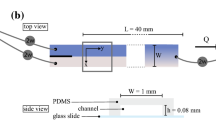Abstract
Molecular motion provides a way for biomolecules to mix and interact in living systems. Quantifying their motion is critical to the understanding of how biomolecules perform its function. However, it has been a challenged task to spatially map the fast diffusion of unbound proteins in the heterogenous intracellular environment. Here we reported a new imaging technique named cumulative area based on single-molecule diffusivity mapping (CA-SMdM). The strategy is based on the comparison of single-molecule images between a shorter and longer exposure time. With longer exposure time, molecules will travel further, thus giving more blurred single-molecule images, hence implying its local diffusion rates. We validated our technique through measuring the fast diffusion rates (10–40 µm2/s) of fluorescent dye in glycerol-water mixture, and found the values fit well with Stokes-Einstein equation. We further showed that the spatially mapping of diffusivity in live cells is plausible through CA-SMdM, and it faithfully reported the local diffusivity heterogeneity in cytosol and nucleus. CA-SMdM provides an efficient way to mapping the local molecular motion, and therefore will have profound applications in probing the biomolecular interactions for living systems.

Similar content being viewed by others
References
Kusumi A, Tsunoyama TA, Hirosawa KM, Kasai RS, Fujiwara TK. Nat Chem Biol, 2014, 10: 524–532
Liu C, Liu YL, Perillo EP, Dunn AK, Yeh HC. IEEE J Sel Top Quantum Electron, 2016, 22: 64–76
Appelhans T, Richter CP, Wilkens V, Hess ST, Piehler J, Busch KB. Nano Lett, 2012, 12: 610–616
Yildiz A. Nat Rev Mol Cell Biol, 2021, 22: 73
Robson A, Burrage K, Leake MC. Phil Trans R Soc B, 2013, 368: 20120029
Westra M, MacGillavry HD. Membranes, 2022, 12: 650
Kusumi A, Shirai YM, Koyama-Honda I, Suzuki KGN, Fujiwara TK. FEBS Lett, 2010, 584: 1814–1823
Sergé A, Bertaux N, Rigneault H, Marguet D. Nat Methods, 2008, 5: 687–694
Appelhans T, Busch K. Methods Mol Biol, 2017, 1567: 273–291
Shen H, Tauzin LJ, Baiyasi R, Wang W, Moringo N, Shuang B, Landes CF. Chem Rev, 2017, 117: 7331–7376
Lippincott-Schwartz J, Snapp E, Kenworthy A. Nat Rev Mol Cell Biol, 2001, 2: 444–456
Li N, Zhao R, Sun Y, Ye Z, He K, Fang X. Natl Sci Rev, 2017, 4: 739–760
Martinez-Moro M, Di Silvio D, Moya SE. Biophys Chem, 2019, 253: 106218
Tian Y, Martinez MM, Pappas D. Appl Spectrosc, 2011, 65: 115–124
Lippincott-Schwartz J, Snapp EL, Phair RD. Biophys J, 2018, 115: 1146–1155
Michaluk P, Rusakov DA. Nat Protoc, 2022, 17: 3056–3079
Axelrod D, Koppel DE, Schlessinger J, Elson E, Webb WW. Biophys J, 1976, 16: 1055–1069
Wolff JO, Scheiderer L, Engelhardt T, Engelhardt J, Matthias J, Hell SW. Science, 2023, 379: 1004–1010
Xiang L, Chen K, Yan R, Li W, Xu K. Nat Methods, 2020, 17: 524–530
Elf J, Li GW, Xie XS. Science, 2007, 316: 1191–1194
English BP, Hauryliuk V, Sanamrad A, Tankov S, Dekker NH, Elf J. Proc Natl Acad Sci USA, 2011, 108: E365–E373
Steele I, Jermak H, Copperwheat C, Smith R, Poshyachinda S, Soonthorntham B. Experiments with synchronized SCMOS cameras. In: Conference on High Energy, Optical, and Infrared Detectors for Astronomy VII. Edinburgh, Scotland, 2016. 991522
Chang WJ, Dai F, Na QY. The challenge of SCMOS image sensor technology to EMCCD. In: 4th Seminar on Novel Optoelectronic Detection Technology and Application. Nanjing, 2018. 1069711
Almada P, Culley S, Henriques R. Methods, 2015, 88: 109–121
Serag MF, Abadi M, Habuchi S. Nat Commun, 2014, 5: 5123
Boersma AJ, Zuhorn IS, Poolman B. Nat Methods, 2015, 12: 227–229
Choi AA, Xiang L, Li W, Xu K. J Am Chem Soc, 2023, 145: 8510–8516
Segur JB, Oberstar HE. Ind Eng Chem, 1951, 43: 2117–2120
Topping J. Phys Bull, 1956, 7: 281
Zhang M, Chang H, Zhang Y, Yu J, Wu L, Ji W, Chen J, Liu B, Lu J, Liu Y, Zhang J, Xu P, Xu T. Nat Methods, 2012, 9: 727–729
Swaminathan R, Hoang CP, Verkman AS. Biophys J, 1997, 72: 1900–1907
Acknowledgements This work was supported by the National Key R&D Program of China (2022YFA1305400) and the National Natural Science Foundation of China (22104113, 22274122).
Author information
Authors and Affiliations
Corresponding author
Ethics declarations
Conflict of interest The authors declare no conflict of interest.
Additional information
Supporting information The supporting information is available online at http://chem.scichina.com and http://link.springer.com/journal/11426. The supporting materials are published as submitted, without typesetting or editing. The responsibility for scientific accuracy and content remains entirely with the authors.
Rights and permissions
About this article
Cite this article
Gao, H., Han, C. & Xiang, L. Spatially mapping the diffusivity of proteins in live cells based on cumulative area analysis. Sci. China Chem. 66, 3307–3313 (2023). https://doi.org/10.1007/s11426-023-1764-x
Received:
Accepted:
Published:
Issue Date:
DOI: https://doi.org/10.1007/s11426-023-1764-x




